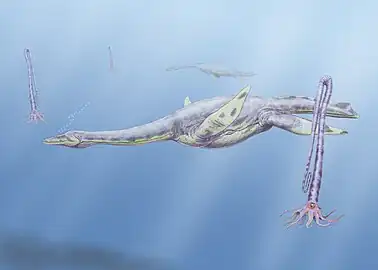| Diplomoceras Temporal range: Late Cretaceous, | |
|---|---|
 | |
| Life restoration of Diplomoceras around Aristonectes | |
| Scientific classification | |
| Domain: | Eukaryota |
| Kingdom: | Animalia |
| Phylum: | Mollusca |
| Class: | Cephalopoda |
| Subclass: | †Ammonoidea |
| Order: | †Ammonitida |
| Suborder: | †Ancyloceratina |
| Family: | †Diplomoceratidae |
| Genus: | †Diplomoceras Hyatt, 1900 |
| Species[1] | |
| |
| Synonyms | |
| |
Diplomoceras is a genus of ammonites included in the family Diplomoceratidae.[2] Fossils of species within this genus have been found in the Late Cretaceous sediments (age range: Campanian-Maastrichtian).[3][4] D. maximum had coiled shell length about 1.5 m (4.9 ft), uncoiled shell being 3 m (9.8 ft) to over 4 m (13 ft), with body chamber around 2 m (6.6 ft).[5][6][7] Some partial specimens may belong to shell with length around 1.7 m (5.6 ft).[8] Studies of Diplomoceras suggest that members of this genus could reach lifespans of over 200 years.[9]
References
- ↑ F. M. Anderson. (1958). Upper Cretaceous of the Pacific Coast. Geological Society of America Memoir 71:1-378
- ↑ Spath L. F. (1926). A Monograph of the Ammonoidea of the Gault; Part VI. Palaeontographical Society London
- ↑ Docho Dochev, Lubomir Metodiev (December 2016). "New record of Diplomoceras cylindraceum (Defrance, 1816) from the Maastrichtian of the Western Fore-Balkan (Bulgaria)". Geologica Balcanica. 45: 33–45. doi:10.52321/GeolBalc.45.0.33.
- ↑ Paleobiology database
- ↑ Zinsmeister, WJ; Oleinik, AE (1995). "Discovery of a remarkably complete specimen of the giant cephalopod Diplomoceras maximum from the Late Cretaceous of Seymour Island, Antarctica". Antarctic Journal of the United States.
- ↑ Syracuse University; Artruc, Emily G.; Ivany, Linda C. (2016). "GROWTH RATE AND ECOLOGY OF THE GIANT HETEROMORPH AMMONITE DIPLOMOCERAS MAXIMUM USING STABLE ISOTOPES OF ACCRETIONARY SHELL CARBONATE". doi:10.1130/abs/2016NE-272500.
{{cite journal}}: Cite journal requires|journal=(help) - ↑ "Giant Heteromorph Ammonite". Paleontological Research Institution. 2023-07-25.
- ↑ Masukawa, Genya; Ando, Hisao (2018-11-01). "Late Campanian–early Maastrichtian heteromorph-dominated ammonoid assemblages of the Nakaminato Group, central Honshu, Japan: biostratigraphic and paleontological implications". Cretaceous Research. 91: 362–381. doi:10.1016/j.cretres.2018.06.018. ISSN 0195-6671.
- ↑ Sullivan, Rory (4 November 2020). "Large squid-like creature that looked like a giant paperclip lived for 200 years — 68 million years ago". The Independent. Archived from the original on 4 November 2020.
This article is issued from Wikipedia. The text is licensed under Creative Commons - Attribution - Sharealike. Additional terms may apply for the media files.